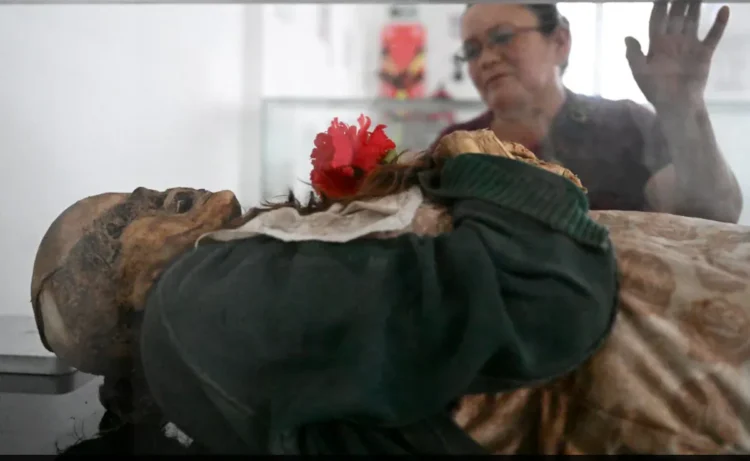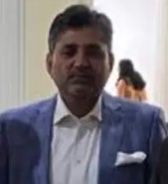Eternally Still: The Inexplicable “Spontaneous” Mummies in a Colombian Town
San Bernardo, Colombia: Clovisnerys Bejarano kneels in front of a glass box containing her mother’s frozen body, which was discovered thirty years ago but seems to be dozing off. The town is located high in the Colombian Andes.

Clasping a false red carnation in her amazingly well-preserved hands, Saturnina Torres de Bejarano is wearing the same green woolen jersey and dress with rose prints that she was buried in.
Bejarano, 63, told AFP that her mother’s ultimate resting place is a museum that houses the bodies of 13 people from the town of San Bernardo who were strangely and spontaneously mummified after passing away. “She still has her little brown face, round, her braids, and her hair,” Bejarano said.
Living around 100 kilometers (62 miles) south of Bogota, Bejarano remarked, “If God wanted to preserve her, it must be for a reason.”
In 1993, Torres was buried at the San Bernardo Municipal Cemetery in a crypt.
When her body was exhumed in 2001, as is usual to make room for new remains, her family discovered that she was still alive and that a large portion of her tissue was undamaged.
It was hardly a huge surprise. Since the first vault was opened in 1963, several mummified remains have emerged.
“When all this began, people were a little incredulous about what was happening; they thought these were going to be isolated events,” Rocio Vergara, the museum guide, said.
“As time went on, it became more and more frequent to find bodies in this condition,” she said to AFP.
Some even retained their eyeballs, which normally disintegrated quickly.
According to Vergara, the number of mummies discovered in the tomb annually has decreased from around 50 in the late 1980s to a small number now.
Reward after demise?
Experts have made several efforts to explain the occurrence, which has also been seen in Mexico and Italy, but they have never been able to determine why the spontaneous mummification in San Bernardo occurred, according to Vergara.
According to Vergara, there are others in the area who “believe” that the reason for the process of mummification is because the deceased person was too wonderful, and it’s their last recompense.
“There are others who consider that… it is a punishment.”
The majority are certain that it is due to the busy, rural lifestyle and nutritious cuisine of the people who live in temperate San Bernardo.
However, the evidence does not always support this. For example, Jorge Armando Cruz, who lived most of his life in the large city of Bogota, died there and was subsequently returned to his birthplace for burial. His mummy is associated with him.
The mummifications exhibit no discernible pattern; the individuals engaged in them all died at varying ages, and neither gender nor body type is more common than the other.
According to Vergara, no area of the cemetery produces more mummies than another.
Like an oven, many think the burial vaults hold the key to the solution.
San Bernardo’s first mummies weren’t discovered until after the cemetery—which lacks subterranean graves—was opened.
According to Vergara, the town had two cemeteries before the 1960s, and there was no documented instance of mummification there.
She also mentioned that the humid atmosphere in the region should normally promote decomposition rather than prevent it.
The cemetery’s location on a precipitous mountain slope may be the cause of the occurrence, according to anthropologist Daniela Betancourt of the National University of Colombia.
Because it’s hot outside, the wind blows continuously. One may imagine that the vaults operate similarly to an oven in that they cause dehydration.”
According to Betancourt (AFP, this theory still has to be investigated.
“There has been a lack of studies about what is happening and what specific conditions are the ones that cause people to mummify,” she said.
The mummified bodies’ relatives must provide permission for the museum to show them.
While most choose cremation, the Bejarano family did not want Torres to suffer that way.
“Here she is, the one God intended to leave to us.” How could one let her be cremated, seeing her like that?” Bejarano questioned, having taken Torres’s great-grandchildren to see her grave on a regular basis.







